The Hakone Open Air Museum is located in the heart of the Japanese countryside. Nestled in between the green hills and valleys of Fuji-Hakone-Izu National Park. Most people who travel to the Hakone region come for the views and the onsens, not the art; I highly recommend making a stop here; trust me, you won’t regret it!
Sculpture is an art of the open air
Henry Moore
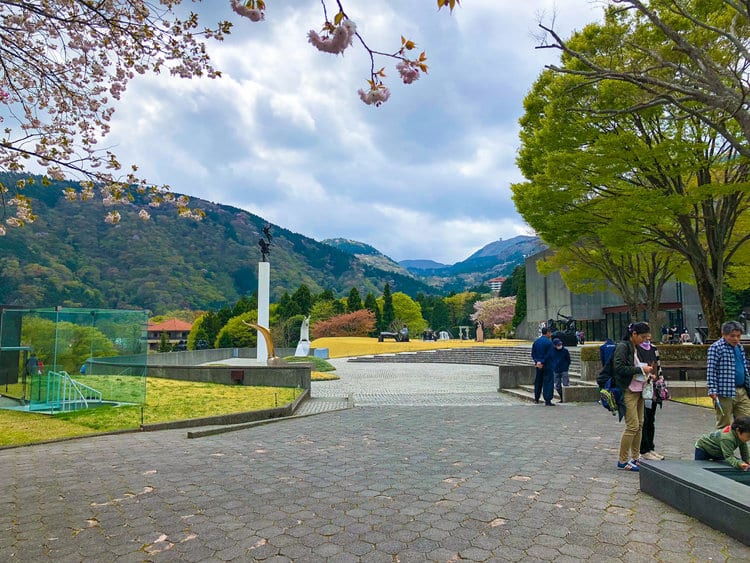
- Access
- Hours and Costs
- History
- Gallery Guide
- Garden of Stars
- Personnage
- Woods of Net
- Wonder Space 2
- Ossip Zadkine
- Picasso Building
- Le Fleur Qui Marche
- Symphonic Sculpture
- Interior of the Tower
- Footbaths
- Reclining Figure
- Close
- Miss Black Power
- Mother and Child
- The Hand of God
- Grande Racconto
- Space Construction
- Sphere within Sphere
- Sixteen Turning Sticks
- Never-Ending Dialogue
- Balzac
- Gift Shop

Access
Train
Travelling on the Tozan Railway from Hakone-Yumoto station will be free if you get the Hakone Free Pass. If you choose not to get the pass, the journey will cost 400 yen ($4 USD). It takes about 30 minutes from Hakone-Yumoto to get to Chokoku No Mori station. Be sure to get a window seat for the journey since the trip is one of the most scenic rides you can have in Japan.
Car
If you are travelling by car, the museum has a large parking lot where you can leave your car while visiting the museum. Google map is a great resource for your journey, but it will end with driving down prefectural road 723 where you’ll find the museum.
Bus
If you’re coming from somewhere in Hakone, not near any of the big train stations, you can take one of the many buses over to the museum. Take the Izu-Hakone Bus to the Ninotaira Iriguchi bus stop. From here, it is only a 5-minute walk to the museum.
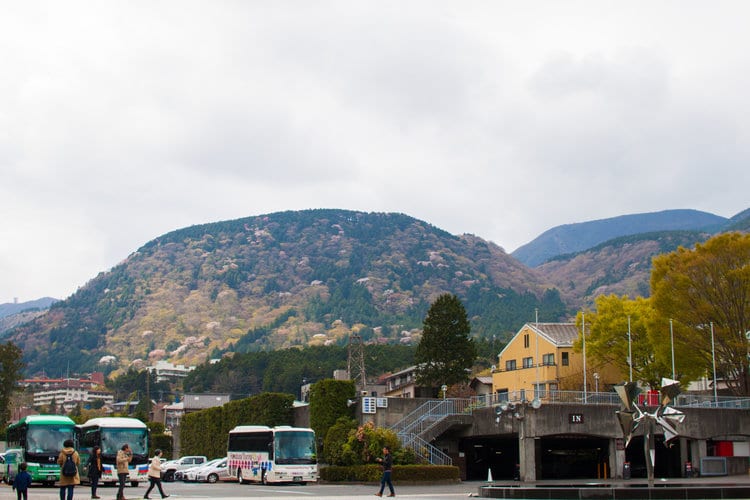
Hours and Costs
The museum is open from 9:00 to 17:00, 365 days a year! Admission is 1600 yen (USD 12) or 1500 yen (USD 11) if you print out this discounted ticket pass. Just print out the discount page and present it at checkout to save 100 yen.
There are a few dozen lockers outside the museum where you can stash your bags if you have any. We had a few heavy knapsacks with us since we hadn’t checked in at our hotel when we arrived at the museum, and storing them here would have been a great way to explore the museum unencumbered. Lockers cost 400 yen and only accept coins.
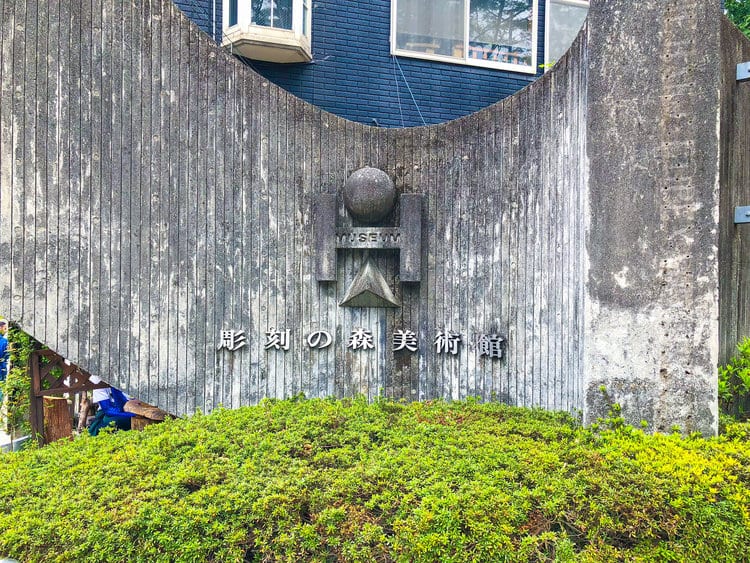
History
The museum was opened in 1966 to create a space where there could be a “dialogue between nature and art.” The park is over 70,000 square meters, with over 120 works from Japanese artists and international superstars. The pieces in the gardens are select sculptures from the 19th and 20th centuries.

Gallery Guide
After you pay your admission, you’ll descend an escalator into the park’s central area. The moment you step off the escalator, you’ll see the hillside appear in front of you, marked with almost magical-looking sculptures.

Hercules, the Archer
One of the first pieces you’ll see when you descend is Hercules, the Archer by Emile-Antoine Bourdelle. Emile-Antoine Bourdelle worked as an assistant in Rodin’s studio. While many of their styles are similar, the differences are also stark. Rodin followed a strict analytical modelling technique, whereas Bourdelle wanted to modernize sculpture from its original Greek and Roman influences. The energy in this piece is so dynamic. The archer’s arm is taut, and his muscle flex as he pulls at an invisible bowstring.
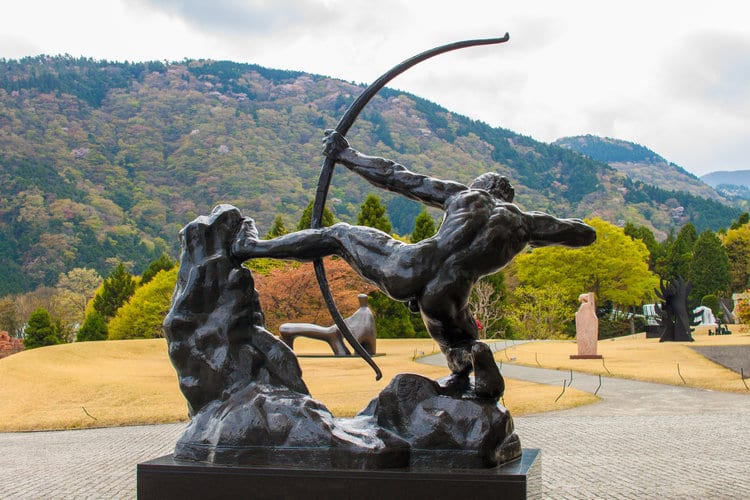
La Pleureuse
Turning left from the Bourdelle, you’ll come up to the fantastical pool of water where an enormous stone head lies. This is La Pleureuse by Francois Xavier and Claude Lalanne. It was sculpted in 1986 using a huge piece of Italian trani stone. La Pleureuse means “the mourner”. She lives in the water, bright green leaves sprouting from her hair. Get up close to the statue, where you can see a teardrop descending from her cheek into the waters below. She is captivating, and her green hair against the cherry blossoms blooming behind her was a perfect composition.
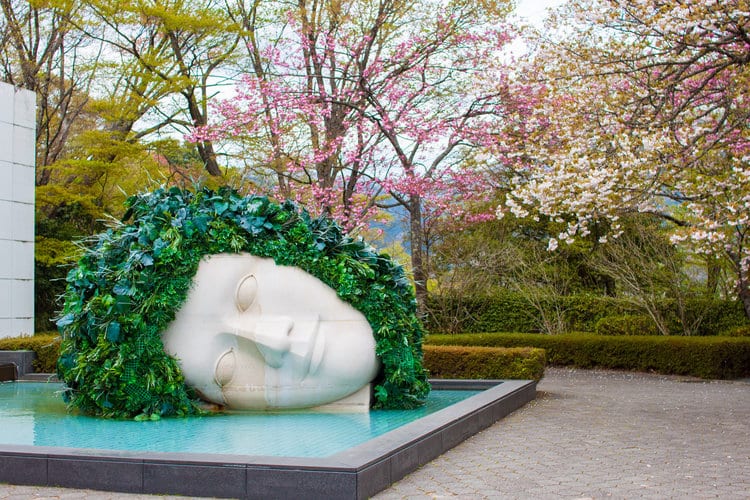
Sky Hole
Behind Le, Pleureuse is one of the famous Sky Holes by Bukichi Inoue. Inoue has several pieces throughout the gardens. Each one allows the user to explore their surroundings from a different perspective. In this piece near the front, the viewer climbs through this tiny doorway into a black box and walks down the stairs into the earth itself. Once down in the depths of the box, there is a small viewing window in the darkness which allows the light to come through and where you can look outside.

Man and Pegasus
After making your way out of the Sky Hole, walk to the large open square where a tall column reaches the sky. Atop the white column is a black sculpture of a man seemingly leaping off a horse. This is Man and Pegasus by Carl Milles. Milles was a Swedish artist who loved creating daring works that integrated themselves into their environment. In this piece, the Pegasus appears to be falling, and from the height of the column, the fall is far more perilous. The man leaps off the back of the horse, only the toes of his foot still touching the Pegasus. He seems to fly forward, defying the laws of gravity. Placed against the dark forest backdrop, the man appears to fly into the clouds.
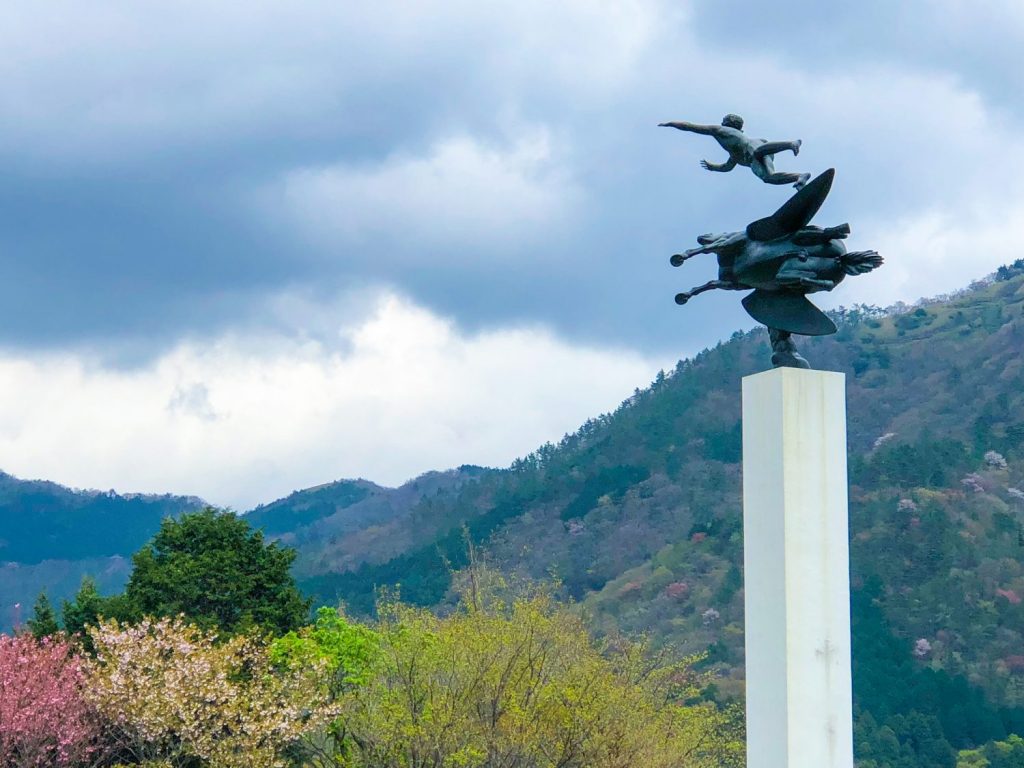
Curved Space-Diamond Structure
Walking down the ramp behind the Milles statue, we come up with the giant gemstone installation by Peter Pearce, Curved Space-Diamond Structure. There are signs all over the piece asking children to remove their shoes and that only kids can play inside. That’s right; if you have any little ones with you, they are more than just allowed to touch the piece; they can climb up inside and explore!
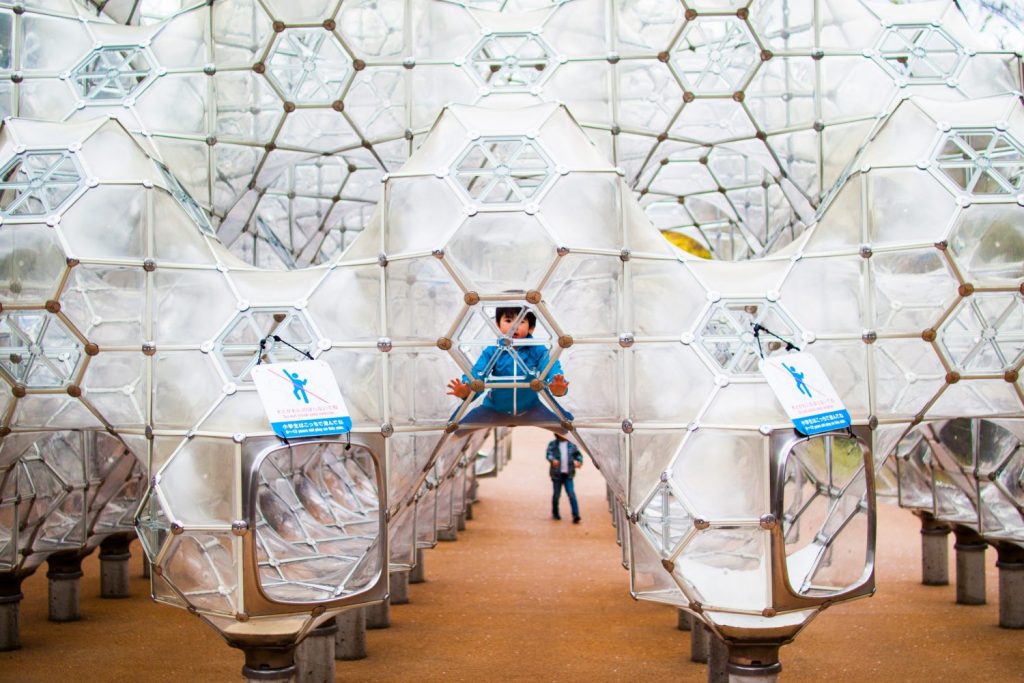
High-Performance Design
While adults aren’t allowed to go inside, you can still explore all the different sides of the piece from every angle. Every so often, catching a glimpse of a brightly coloured sweater or dress passing by. The structure itself was based on the shape of a diamond molecule enlarged 8 billion times. Pearce was always fascinated with natural geometries and “High-Performance Design.” Both of these themes perfectly harmonize with the gallery’s concept.
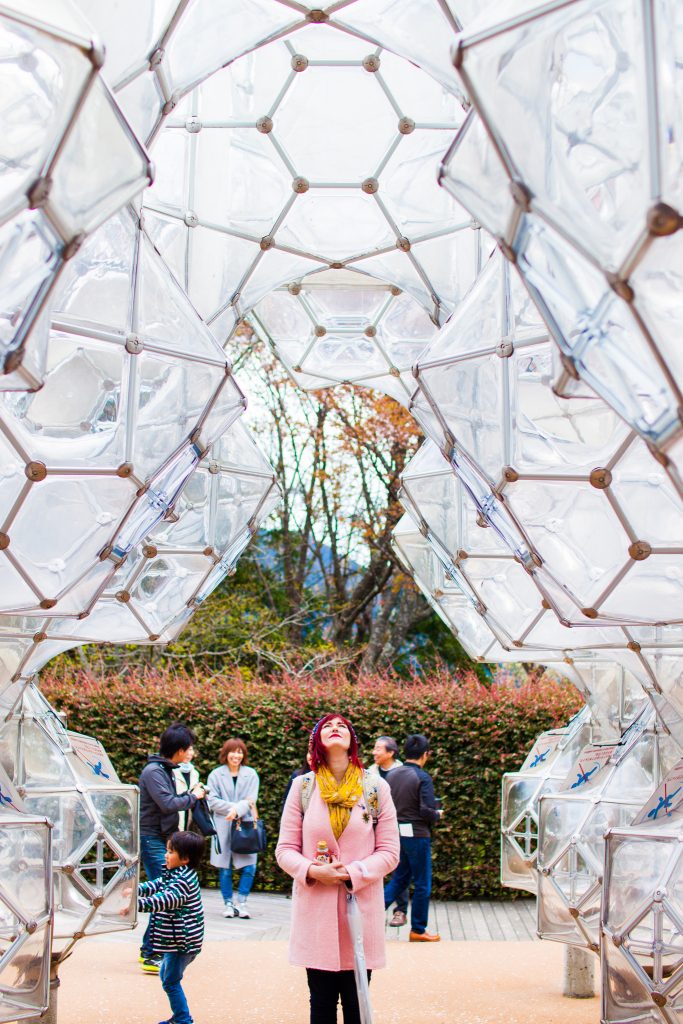
The Space-Diamond is where you can also find one of the only vending machines in the park. Selling hot tea and juice is the perfect thing to grab to warm up or cool down for the remainder of your journey.

Entering the Forest
Walk down the stairs from the Space-Diamond, and you’ll come to a rope bridge which crosses a small pond. On either side of the pond are lushes forests which seem like artworks onto themselves.
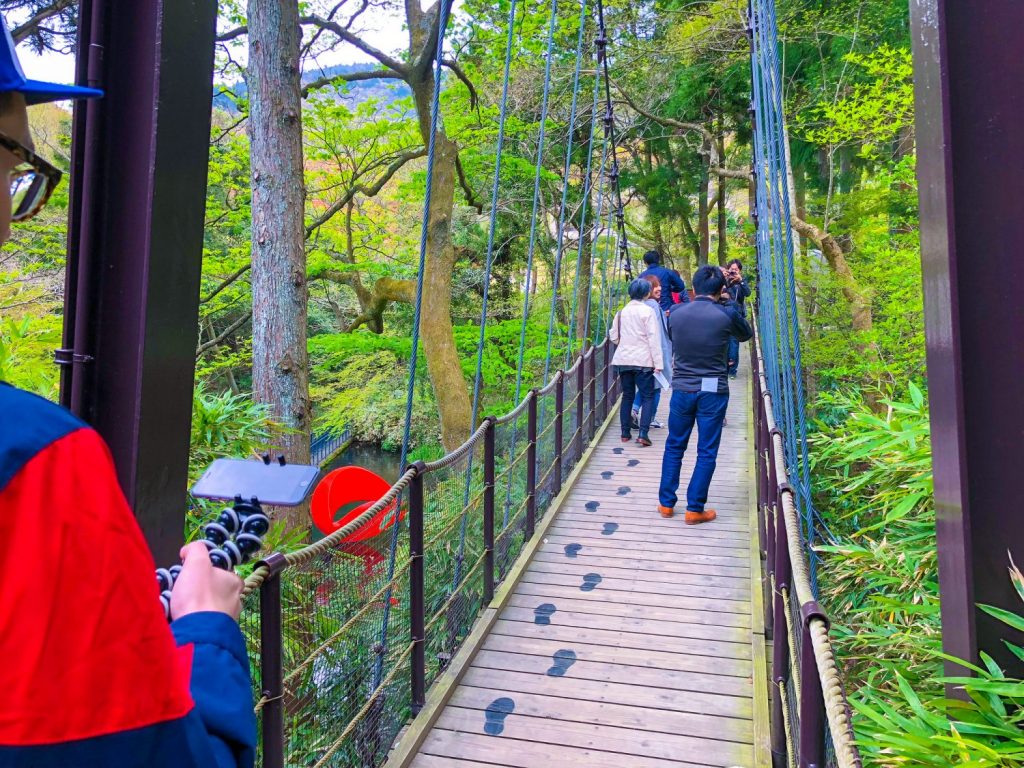
Bronzes
Nestled into the corner to the right of the bridge are several bronze statues by Francesco Messina, Yuki Shintani and Carl Milles. These works of art are all of the people and, from afar, look like little nymphs hiding amongst the trees.
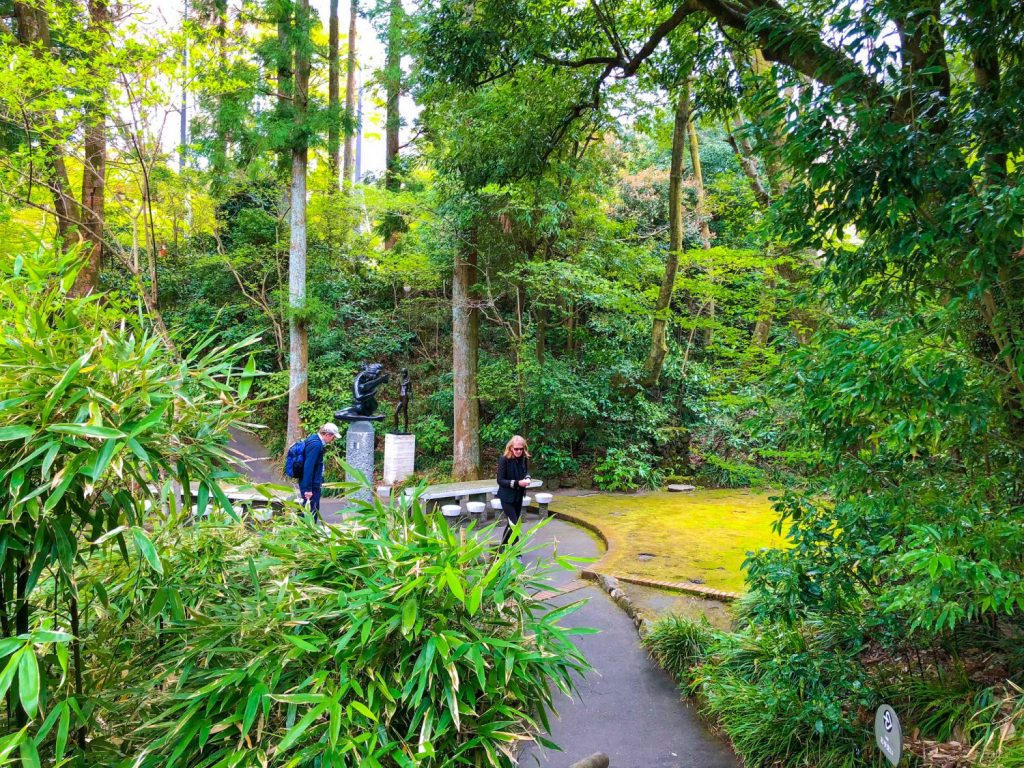
Floating Sculpture 3
To the left of the bridge is Floating Sculpture 3 by Marta Pan. The floating sculptures are painted the same vermillion colours as the Tori gates in Japan. The designs move and sway in the water. Pan was inspired by dancers and their balanced movements when creating this work. In the water swim, dozens of koi fishes dance along with the movement of the kinetic sculptures.

My Sky Hole
Exiting the pond, you walk up a gentle incline, gated by another My Sky Hole by Bukichi Inoue. This is a giant glass sphere held by four thin concrete columns. Craning your head upwards towards the sphere, you can see the world reflected back at you.
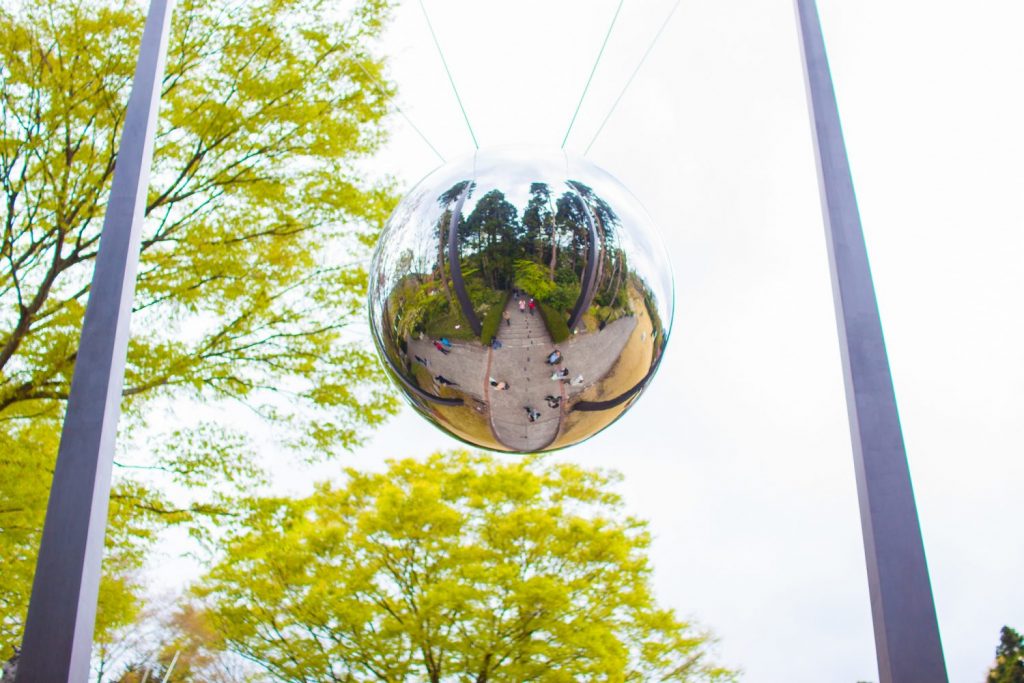
Eva
Walk north towards the garden of stars, and be sure to pass by the Eva by Francesco Messina. Messina, an Italian sculptor born in 1900, is one of the most critical figurative sculptors of the 20th century. His pieces represent the “ideal woman,” unattainable in life, captured only in his art.
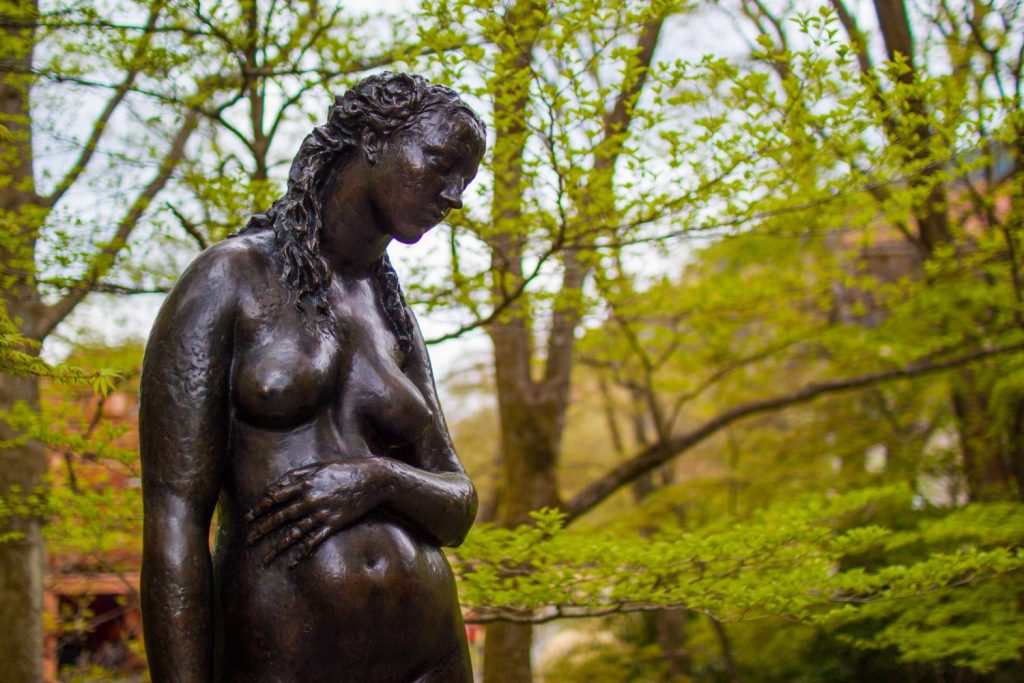
Garden of Stars
Further up the hill, you come upon the Garden of Stars. The Garden of Stars is a giant maze in the shape of multiple inlaid stars. From afar, it looks like nothing more than a flower bed, but on closer inspection, you can see that space between the green grass and flowers is a deep recess where you can explore. Adults can wind their way through the maze, taking time to stop and smell the roses.
Surrounding the maze is a group of statutes by Yoshitatsu Yanagihara. Yoshitatsu Yanagihara was a Japanese sculptor born in 1910. Her work centres around the “spirit of humanistic inquiry into the essence of nature and life”, another good fit for the museum’s theme.

Personnage
To the left of the Garden of Stars, you descend slightly towards Personnage by Joan Miró. Miró was a Spanish artist and one of the most well-known Surrealist sculptors. His work in Personnage explores the idea of art created from poetry. The different shapes and colours plastered onto the forms are like words that create a beautiful poem for him.
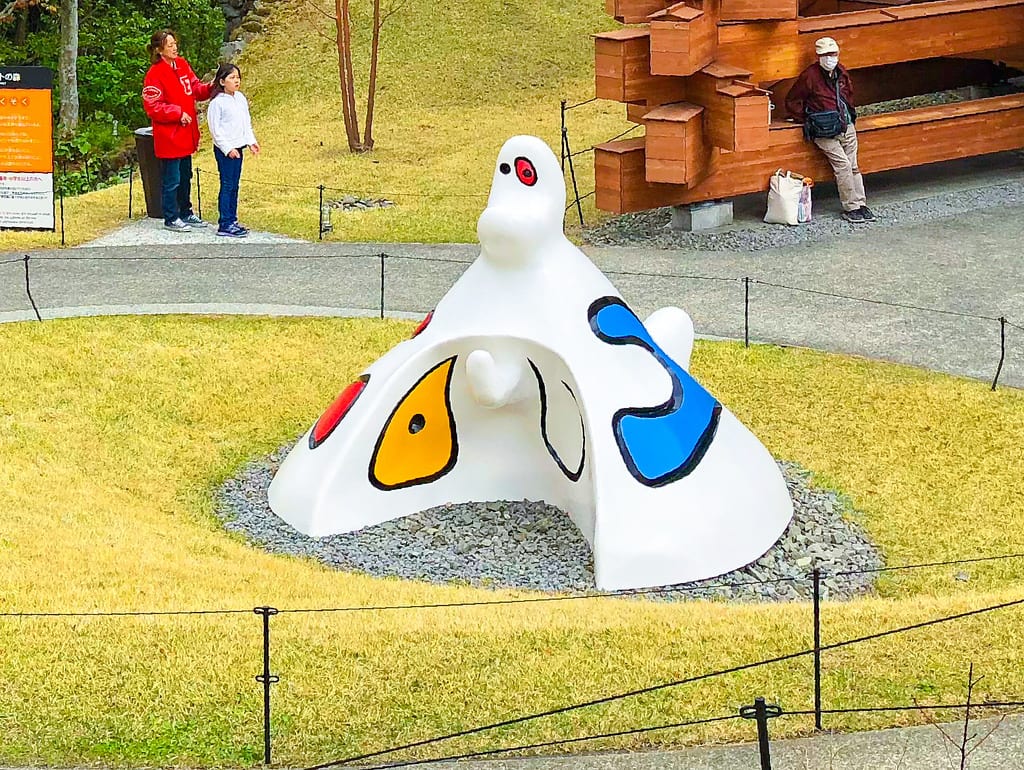
Woods of Net
Behind the Miro is what looks like a meticulous stack of piled wood. Fittingly enough, this piece is called Woods of Net, created by Tezuka Architects. This is one of the only parts in the museum which was created by an architectural team instead of an artist. But without knowing that, you can’t tell the difference, as this piece is overwhelmingly beautiful and transcendent. The structure is made of only strips of timber, without ANY metal! 320 cubic meters of wood was used to create the structure, and over 500 different kinds of wood were used. The technique for the joints inside the pavilion was derived from thousand-year-old Japanese wooden temple designs. When you step inside, the smell of freshly cut wood still permeates the air.

Wonder Space 2
The pavilion was created specifically to hold the works of Canadian artist Toshoiko Horiuchi MacAdam. As you walk through the open gateway, you see the brightly coloured wonder that is Knitted Wonder Space 2. Horiuchi MacAdam went about hand-knitting each piece which hung from the ceiling. Horiuchi MacAdam was inspired by the works of Antoni Gaudi, who also loved incorporating nature’s undulated and curving forms, instead of straight lines and rigid geometry, in his artwork.
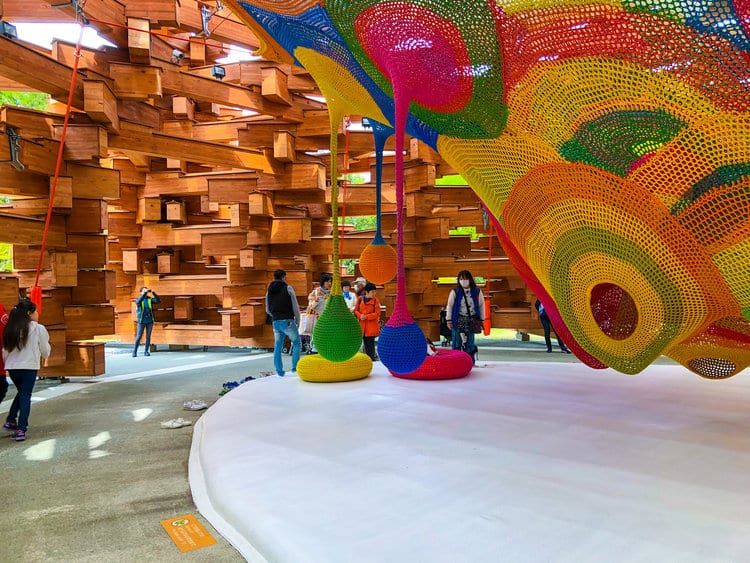
The piece took over 650kg of braided nylon, three months to dye, and over a year spent crocheting the textile into nets. The net is meant to symbolize the cradle of a womb. The net rocks and floats in the air like a baby would be carried inside the mother before birth. Children under a certain weight and age can crawl through the net. The net captures the slightest movement of the child and transmits it back to him like a wave. The more children play inside, the more waves you have, connecting the children in these undulating waves. Maybe one day, she will create something stable enough for adults since even the oldest among us yearn to be a child once more.

Ossip Zadkine
Up the hill from the Wood of Nets is a sculpture by Ossip Zadkine, Van Gogh Marchant à Travers Champs. One of Vincent Van Gogh’s paintings inspired the statue, subsequently destroyed during WWII, of the famous artist walking through the countryside in France with his painting equipment. Van Gogh spent much of his painting career portraying the French landscape around him. It is a lovely tribute to Van Gogh, eternally walking in the outdoors he loved so much.
Picasso Building
Across the bridge, at the very top of the art gallery space, is an enormous building with the words “Picasso” written across the front. Inside this oblong pavilion are over 300 paintings, photographs, ceramics and more created by this legendary artist. Each one was donated to the museum by the artist’s daughter and provided an intimate look into the artist’s life outside his most prolific works. My favourite was the stained glass windows he created using gemmail. Gemmail is formed by fusing layers of coloured glass fragments to create a three-dimensional image. I’d never seen this kind of stained glass, which was absolutely stunning.

Le Fleur Qui Marche
Outside the Pavillion is a giant sculpture by Leger, Le Fleur qui Marche. Leger made himself a household name during the cubist period with his inventive and imaginative paintings. After WWII, he began to explore ceramics and art for public squares. Walking Flowers explores the ideas of nature and the human spirit combining into one anthropomorphic form.

Walking east from the pavilion, you walk through a few small landscape areas of the garden, which feature some small pieces of art, but the focus here is more on the beauty of the natural environment.

Symphonic Sculpture
At the back of the grounds is a modernist cafe where you can buy treats and drinks. They often have seasonal flavours, but prices are steep, as can be expected for gallery cafes. There is also a small souvenir shop where you can purchase different items to commemorate your trip.
Across from the cafe is the most iconic structure in the museum, Symphonic Sculpture by Gabriel Loire. This 18-meter tall circular steel tower is surrounded by brightly coloured stained glass. Once you enter the tower, you ascend a narrow set of winding stairs toward a lookout.
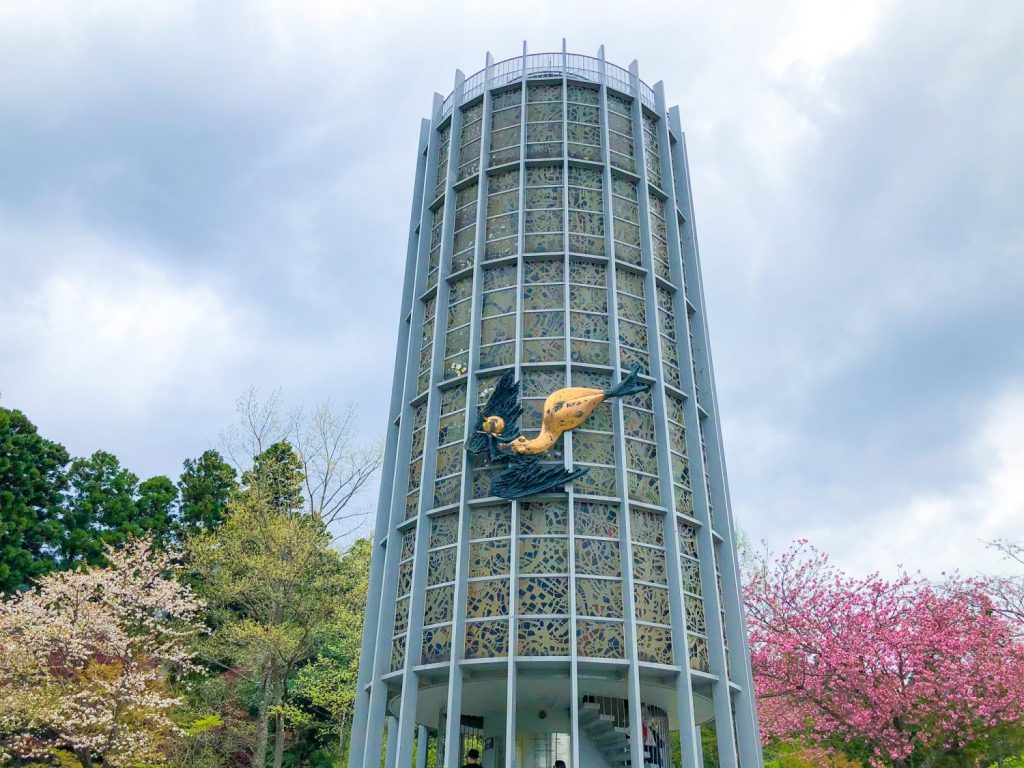
As you walk up the stairs, take time to study the incredible glasswork surrounding you. The stained glass created by Loire is called “slab glass” because it is much thicker than the glass developed in the medieval era. The opaque glass allows for deeper colours, especially when illuminated by bright sunlight. Loire was an impressionist and used glass like Van Gogh used paints to depict the Starry Night, or Monet did with Water Lilies.

Interior of the Tower
From the top of the tower is an incredible view of the Fuji-Hakone-Izu National Park. In the springtime, you can see brightly coloured cherry blossoms colouring the treetops. And in the autumn, a blanket of reds and gold covers the skyline like a warm glow.
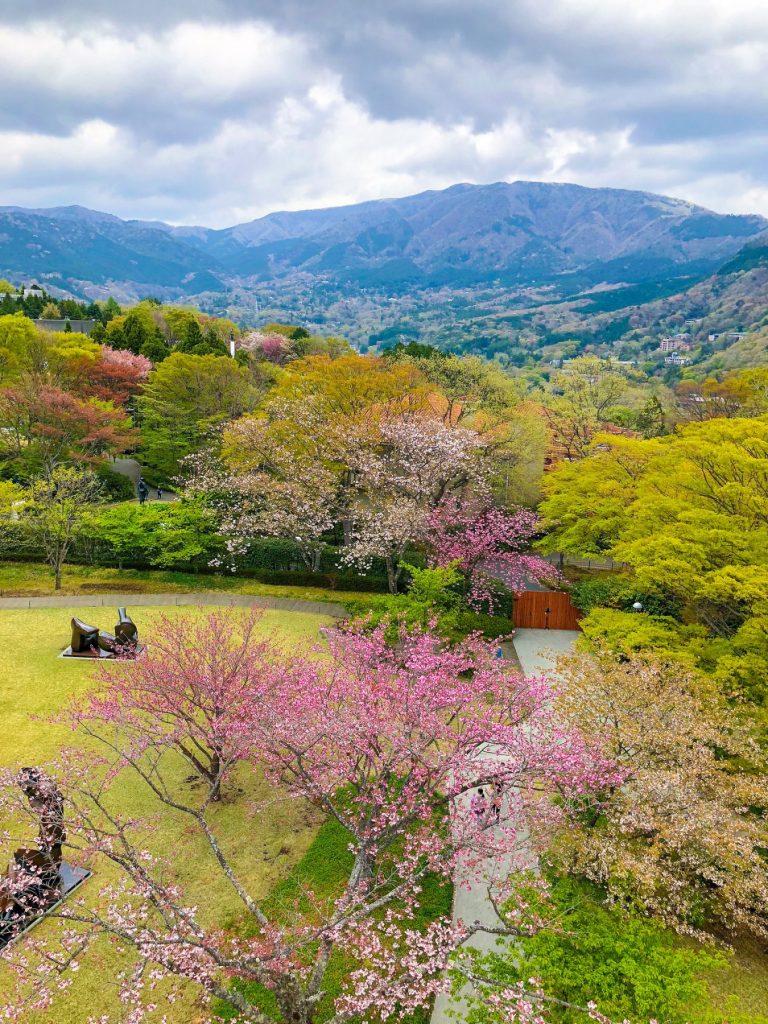
Footbaths
Down a small pathway from the tower are the footbaths. These footbaths are filled with warm water from the hot springs. Here you can sit on the edge of a long bench and dip your tired feet into the water. Press the up and down on the stones beneath to help give yourself a bit of a massage. If you didn’t bring a towel and needed to dry off, you could buy a small souvenir towel from the attendant for only 100 yen.
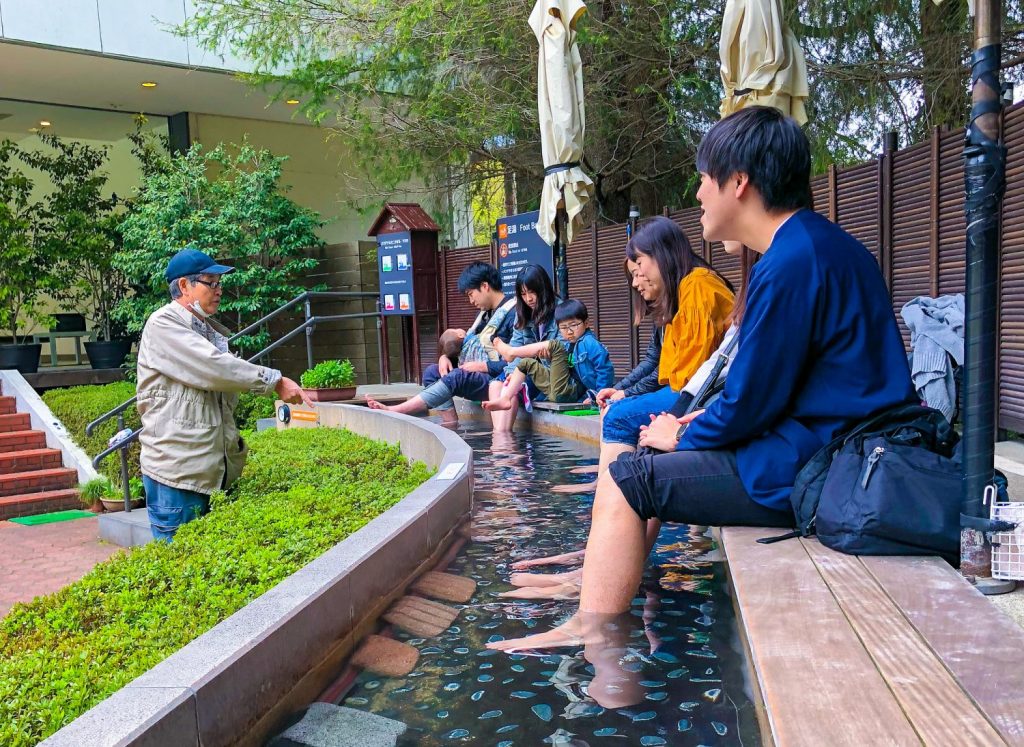
Reclining Figure
As you return to the front of the museum, you’ll pass several figures by Henry Moore. The first is Reclining Figure. Henry Moore found himself possessed by two themes throughout his work; the Mother and Child and the Reclining Figure. The reclining figure symbolized womanhood, life, survival and endurance for Moore.
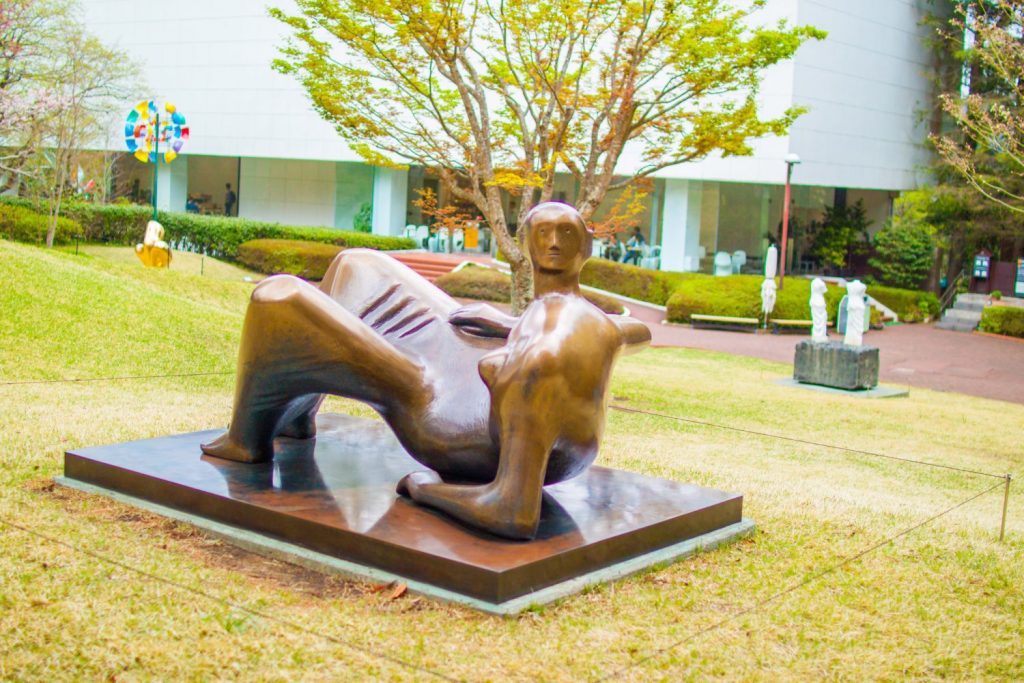
Close
One of the more amusing pieces is Close by Anthony Gormley. A naked bronze cast of a human spread eagle is embedded into the ground. The grass grows around the piece, and it looks like someone has just leapt off a roof and landed on the ground below. Gormley says his work is “an attempt to materialize the place at the other side of appearance where we all live.”

Miss Black Power
The vibrant Miss Black Power by Niki de Saint Phalle is visible through the trees from many areas of the park because she is so brightly painted and enormous in size. Miss Black Power is an extension of Phalle’s significant themes in her work; the role of women in society and social change.

Mother and Child
Mother and Child: Block Seat, once more by Henry Moore, brings to life his modern reinvention of the everlasting image of the Madonna and Child.
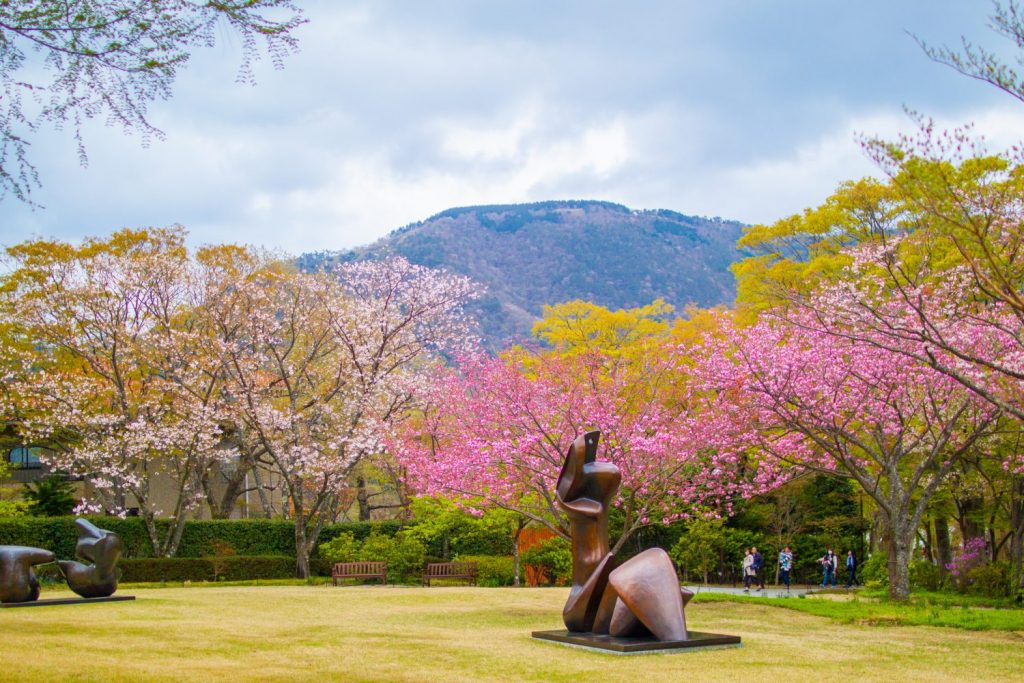
The Hand of God
The Hand of God by Carl Milles was one of the last works this incredible artist ever created. Looking up into the forest, we can see an enormous human hand balancing a naked human form on his thumb and forefinger. The standing man looks to be gazing at the sky like he is watching or listening to something far off in the distance. The is something about this piece being so closely connected to the artist’s death, which makes it all the more poignant.
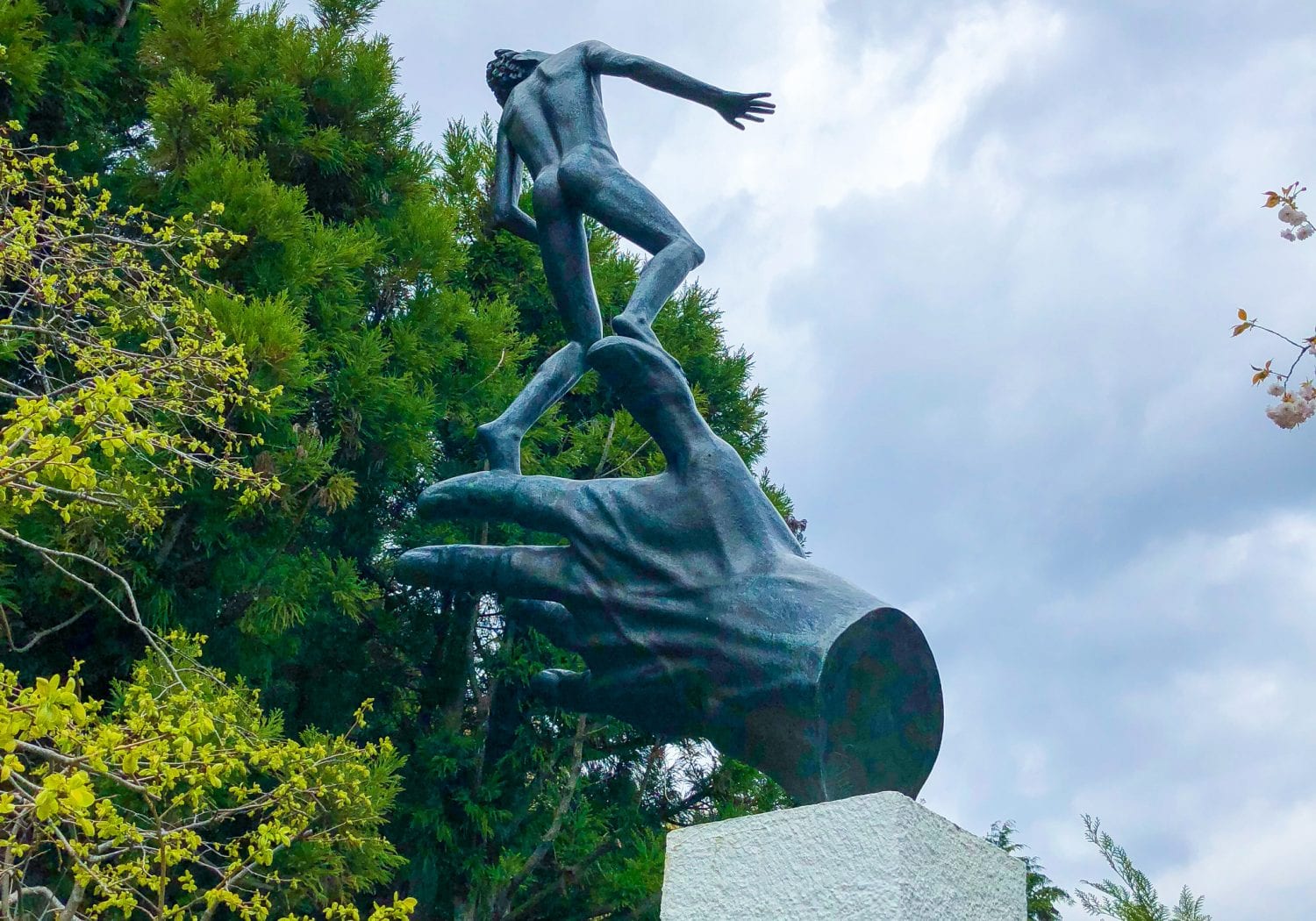
Grande Racconto
Grande Racconto by Giuliano Vangi depicts one man’s journey into the future. He is represented twice in the piece. On one side, you see him overcome with anxiety. As you walk around the sculpture, you see trees take shape out of the stone. On the opposite side, you can see the same man bursting forth into the future, free of fear and ready to face a new day. Perhaps with a better connection to the natural world and the peace that can be found there, you can better face the realities of the human world.

Space Construction
This south side of the garden features more interpretive and modern-looking sculptures. Intersecting Space Construction by Ryoji Goto comprises hundreds of tiny human figures. Each one is in a leaping position, connected to the ones above, below and on either side. The sculpture is meant to symbolize the beauty made through the human connection.

Sphere within Sphere
Sphere Within Sphere by Arnaldo Pomodoro is one of the more famous designs in the gallery. There are other spheres he made in multiple locations all over the world. From afar, it looks like a golden orb with cracks, but as you come closer, you can see that the cracks reveal layers of other spheres inside. Like a Russian nesting doll. A world inside a world inside a world. A commentary perhaps on the introspective nature of humans themselves.
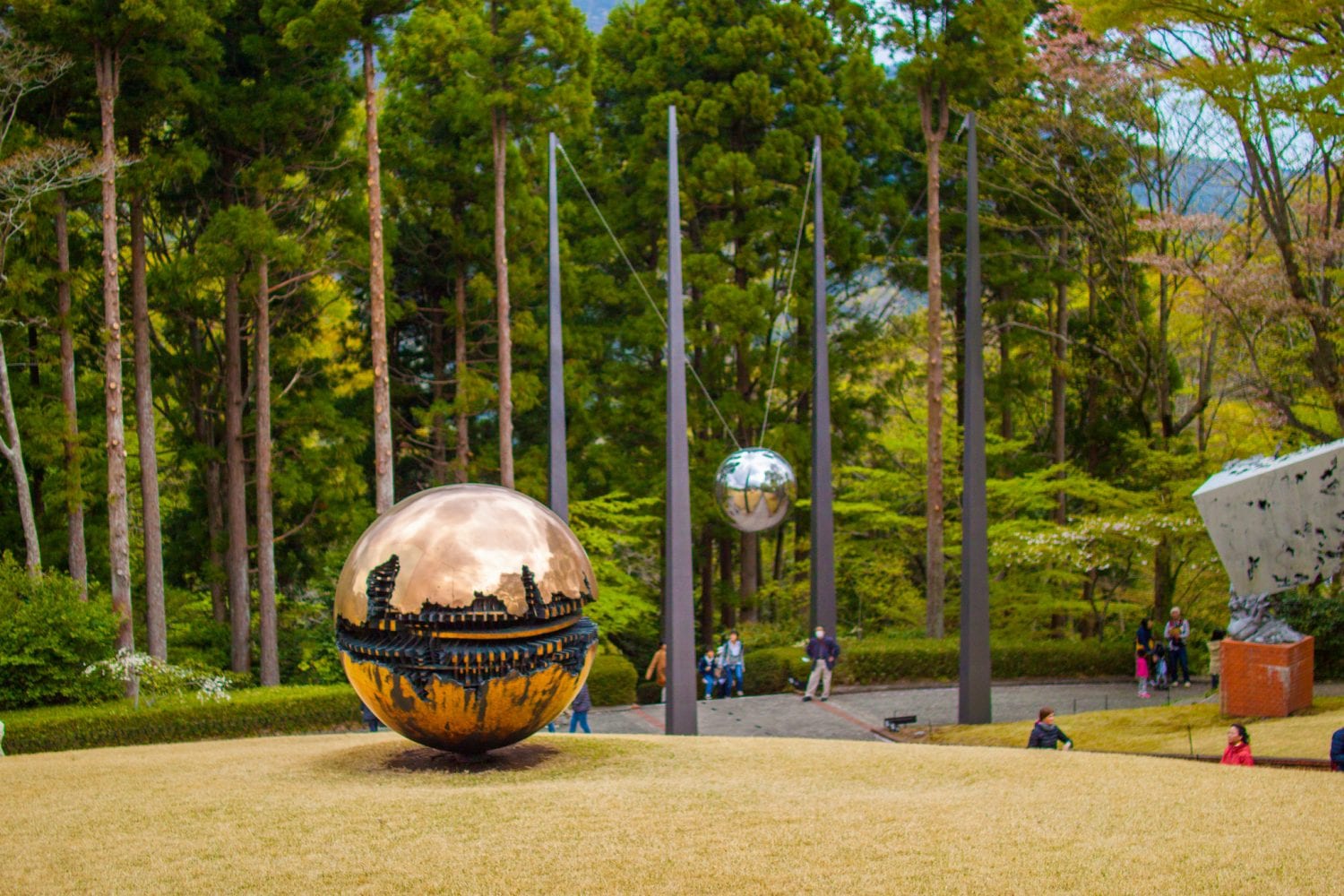
Sixteen Turning Sticks
Sixteen Turning Sticks by Takamichi Ito is a piece that relies on movement and encapsulates your attention. In a sea of silence, this one draws your eye in immediately. Inspired by a window display he created in 1960 when he was a designer, Ito said, “When I decorated the show window with a mobile that danced in the wind, many people stopped to look…People gathered in front of the window, both adults and children, genuinely enjoying the movements of the mobile. After that, I was invited to try and create works in the art world too, and after participating in an exhibition of outdoor sculptures and winning a prize, I became active not only in design but also in the pure art world.”
Never-Ending Dialogue
High in the sky spins a bright vermillion-coloured abstracted bird. This is Never-Ending Dialogue by Susumu Shingu. Shing u’s sculptures are kinetic works of geometry which move with the wind and transform from simple shapes into a moving performances.

Balzac
Balzac by Auguste Rodin is one of the last figures to see before making your way to the exit. Rodin is one of the most astounding sculptors of his generation, or any generation. Balzac was created as a memorial to the French novelist Honoré Balzac. When the statue was first unveiled, people were horrified. It not only looked nothing like the writer but had a ghastly expression. Rodin didn’t want it to be a faithful representation of the man himself, so many others had already done that. He wanted it to express the writer’s persona and the deep and sometimes.
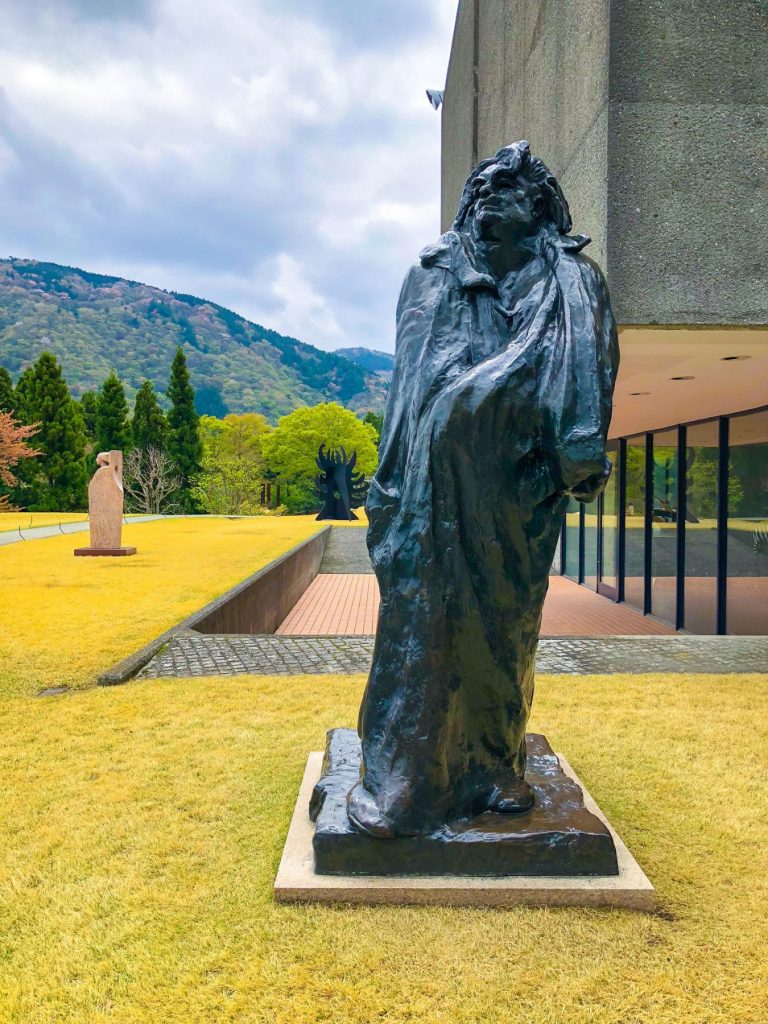
Gift Shop
When you are ready to leave, head towards the exit, heading up another escalator leading to the gift shop. There are many cute gifts reflecting many artists and objects seen inside, but to me, there is something far more interesting opposite the Gift Shop.
Japan does love their Gachapon machines. If you’ve never seen or heard of one, Gachapon is a capsule toy machine dispensing random items from a given set. They all cost different amounts, and you’ll often find unique ones in places like this. Here you have 12 machines, each dedicated to art history. Some dispense buttons with images of the various artworks from the museum on them, and others have a famous painting on coasters or even tiny pieces of framed art! My kind of souvenir and something you’d never find outside of Japan!
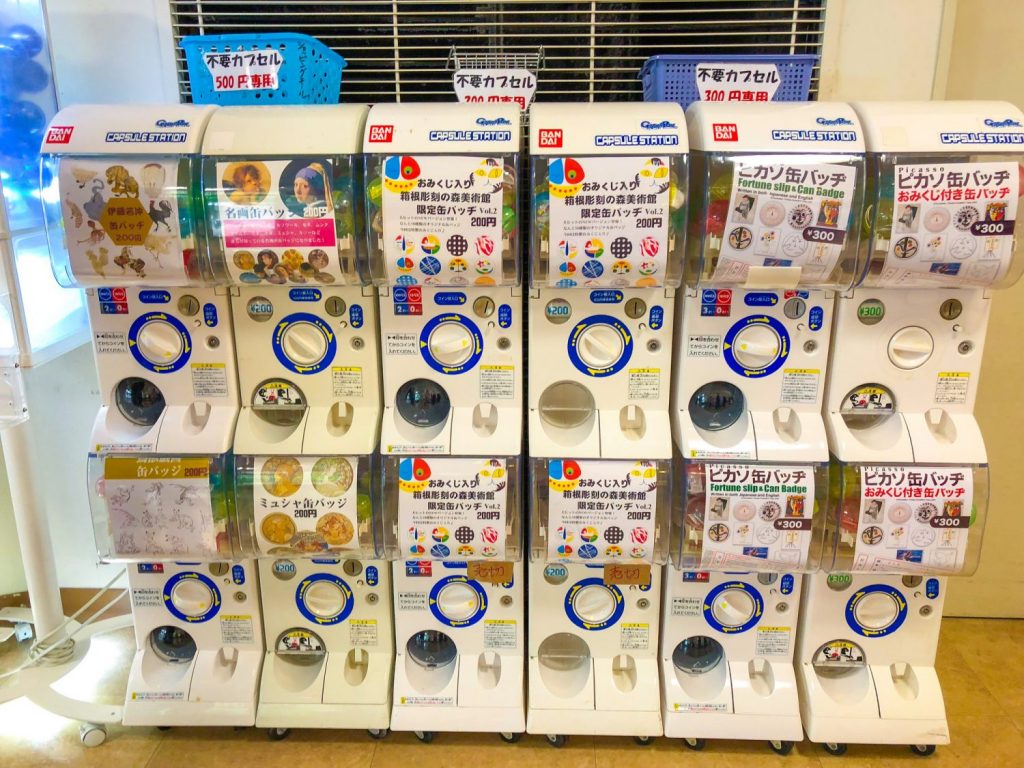
I will be the first to admit that modern art has never been my favourite thing. But here, in this incredibly serene and astonishing environment, the works of art took on a new life. I was better able to appreciate their beauty and understand the stories they were telling. They seemed to speak to me here, under the cherry blossoms and among the tree. Don’t miss it on your next visit to Hakone!







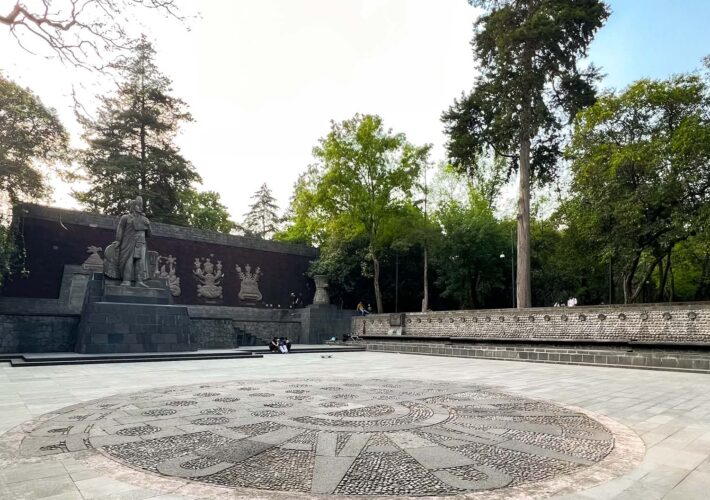


1 COMMENT
Jacob
7 years agoThat Symphonic Sculpture looks stunning!